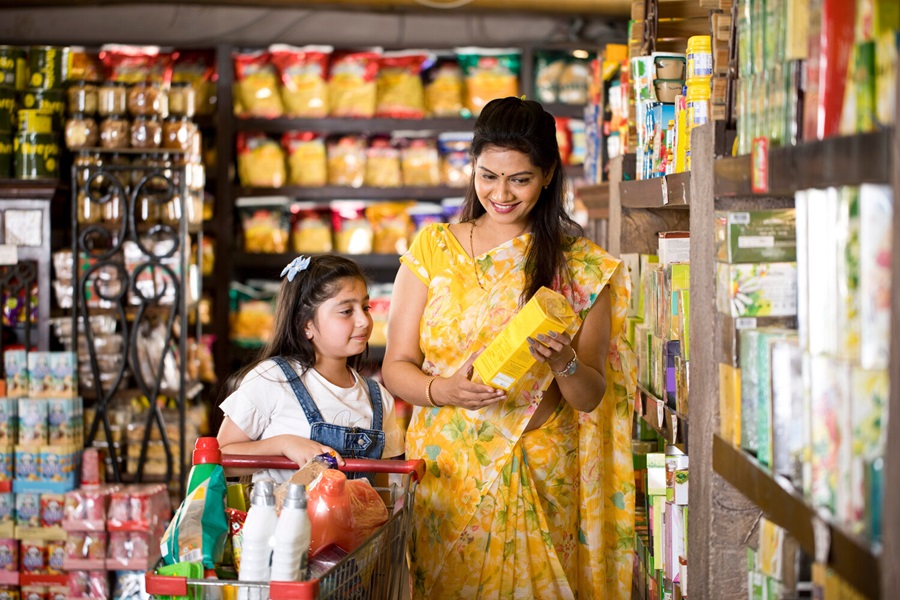The volume of FMCG products purchased for in-home consumption in India grew 4.4% during the May-July quarter – significantly higher than the 2.1% registered in the February-April period. The increase was largely driven by Atta’s 38% volume growth, as the flour brand returned to shoppers’ baskets after the government halted its free grain distribution scheme. Taking Atta out of the equation, FMCG volume growth stands at 1.7%, marginally ahead of the 1.4% growth the previous quarter – a small but definite step forward.
Value sales over the May-July period grew by 13.5%. The gap between volume and value growth has reduced rapidly over the past three quarters; a sign that inflation is easing, and FMCG prices are declining.
Turning our attention to FMCG purchases consumed out of home (OOH), sales volume grew by 94% between February and April, followed by 79% in May-July, among shoppers in larger cities. This mammoth growth is a result of the return to normal activities following COVID, combined with a hot summer: a large proportion of the growth came from refreshment categories including carbonated beverages, ice creams and similar frozen desserts.
Another trend in the OOH space is shrinking pack sizes, with a 14% decrease in size among beverages purchased for OOH consumption, and a 23% decrease among snacks.
Urban areas outpace rural regions
In India’s urban areas, FMCG volume grew 6.1% in the May-July period, compared with 2.8% in rural areas.
The biggest surges in consumption among urban shoppers were in the household care, grooming and hot beverages categories, while cold beverages and snacking led in rural areas. Although rural areas are lagging, there are strong pockets of growth – and the fact that these are in non-essential categories indicates that there are great opportunities for brands.
An increase in trips and packs
The post-pandemic rise in the number of shopping trips Indian consumers are making has continued, albeit at a slower rate than the previous year. Shoppers are making 153 trips annually, with the number in May-July 2023 reaching 40 for the first time.
The number of packs purchased has also increased, standing at 204 in the May-July period, compared with 159 just three years ago. One of the key reasons for this explosion is the movement towards smaller pack sizes, a trend that is expected to continue.
Consumers made an average of 26 OOH trips from January-July 2023, up from 16 during the same period last year, while the number of packs bought soared from 40 to 86. Once again, this has been driven by the return to normal habits following the pandemic, together with a reduction in pack size for beverages and snacks.
The own-label explosion
Private label brands have seen tremendous growth in India over the last year, particularly in the toilet cleaners and noodles categories where they have a penetration of 6% and 3.5% respectively. Retailers including Reliance Retail, Future Group, More Retail, D-Mart, Apollo and Star Bazaar have all launched their own product ranges.
Exploring new tastes
As Indian shoppers’ buying power increases, they are searching for new experiences, and the food sector has responded with the launch of some new and unique product offerings – including savoury potato crackers, Korean flavoured noodles, and energy drinks.
According to Kantar data, 3.4% of shoppers bought energy drinks to consume OOH in the May-July quarter, while 1.3% purchased the category to consume in-home. Traditionally considered to be an indulgence, the segment is being boosted by the emergence of competitively priced brands such as Sting.
In conclusion, the mood in India is upbeat. Consumer sentiment is positive, and the environment conducive. However, the market remains complex. Local and global pressures including demonetisation, war, COVID and inflation have all had an impact, and shoppers have become experts in dealing with change.
Kantar Worldpanel’s experts can help you understand how shoppers’ motivations and behaviour are changing, and where the opportunities lie. For instance, Kantar data shows that 35% of Indian consumers believe that manufacturers should be the ones driving sustainability initiatives for the country, a clear message that they want brands to do more than just sell goods.
Fill in the form below to download the latest report on India's FMCG market. Experiencing some issues? Click here.

